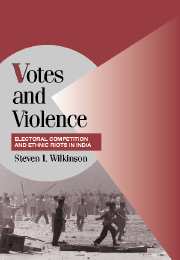Book contents
- Frontmatter
- Contents
- List of Figures
- List of Tables
- Acknowledgments
- 1 THE ELECTORAL INCENTIVES FOR ETHNIC VIOLENCE
- 2 EXPLAINING TOWN-LEVEL VARIATION IN HINDU-MUSLIM VIOLENCE
- 3 STATE CAPACITY EXPLANATIONS FOR HINDU-MUSLIM VIOLENCE
- 4 THE CONSOCIATIONAL EXPLANATION FOR HINDU-MUSLIM VIOLENCE
- 5 THE ELECTORAL INCENTIVES FOR HINDU-MUSLIM VIOLENCE
- 6 PARTY COMPETITION AND HINDU-MUSLIM VIOLENCE
- 7 THE ELECTORAL INCENTIVES FOR ETHNIC VIOLENCE IN COMPARATIVE PERSPECTIVE
- 8 DEMOCRACY AND ETHNIC VIOLENCE
- Appendix A Data Sources for Hindu-Muslim Riots
- Appendix B Data-Entering Protocol for Riot Database
- Appendix C Additional Results from Statistical Tables
- References
- Index
- Cambridge Studies in Comparative Politics
5 - THE ELECTORAL INCENTIVES FOR HINDU-MUSLIM VIOLENCE
Published online by Cambridge University Press: 28 July 2009
- Frontmatter
- Contents
- List of Figures
- List of Tables
- Acknowledgments
- 1 THE ELECTORAL INCENTIVES FOR ETHNIC VIOLENCE
- 2 EXPLAINING TOWN-LEVEL VARIATION IN HINDU-MUSLIM VIOLENCE
- 3 STATE CAPACITY EXPLANATIONS FOR HINDU-MUSLIM VIOLENCE
- 4 THE CONSOCIATIONAL EXPLANATION FOR HINDU-MUSLIM VIOLENCE
- 5 THE ELECTORAL INCENTIVES FOR HINDU-MUSLIM VIOLENCE
- 6 PARTY COMPETITION AND HINDU-MUSLIM VIOLENCE
- 7 THE ELECTORAL INCENTIVES FOR ETHNIC VIOLENCE IN COMPARATIVE PERSPECTIVE
- 8 DEMOCRACY AND ETHNIC VIOLENCE
- Appendix A Data Sources for Hindu-Muslim Riots
- Appendix B Data-Entering Protocol for Riot Database
- Appendix C Additional Results from Statistical Tables
- References
- Index
- Cambridge Studies in Comparative Politics
Summary
Why do some political leaders in some Indian states impress upon their local officials that communal riots and anti-Muslim pogroms must be prevented at all costs? Why do governments in other states fail to protect their minorities or even incite violence against them? In previous chapters we showed that factors such as declining state capacity or India's changing level of consociational power sharing cannot explain the geographical or historical patterns in the effectiveness of states' response to the threat of communal violence. In this chapter, I argue that we can best explain state-level variation in levels of Hindu-Muslim violence if we understand the electoral incentives facing each state's government. I show that states with higher degrees of party fractionalization, in which minorities are therefore pivotal swing voters, have lower levels of violence than states with lower levels of party competition. This is because minorities in highly competitive party systems can extract promises of greater security from politicians in return for their votes.
The chapter is organized into three parts. First, I develop the theoretical argument about the importance of state-level electoral incentives and outline the conditions under which high levels of multiparty electoral competition will lead to higher levels of state protection for minorities. Second, using data from 1961 to 1995 for 14 major Indian states, I show that greater party fractionalization leads to a statistically significant reduction in states' levels of Hindu-Muslim riots.
- Type
- Chapter
- Information
- Votes and ViolenceElectoral Competition and Ethnic Riots in India, pp. 137 - 171Publisher: Cambridge University PressPrint publication year: 2004

